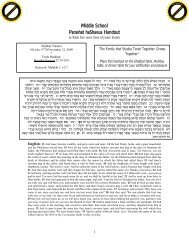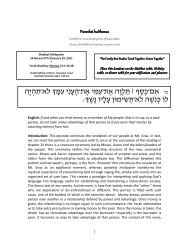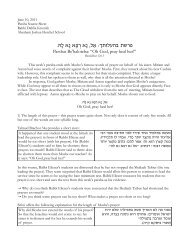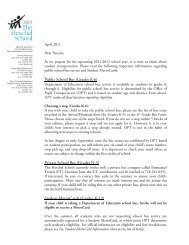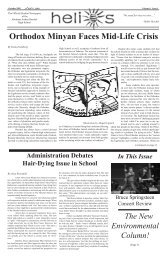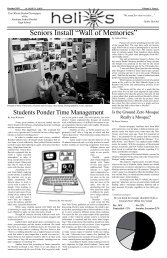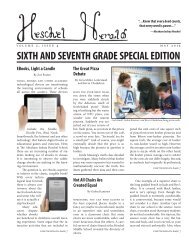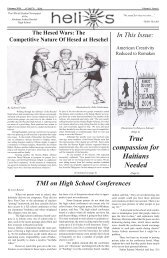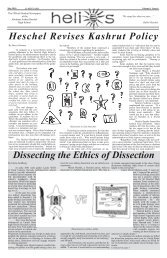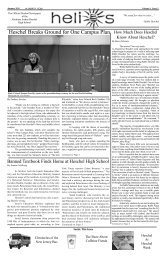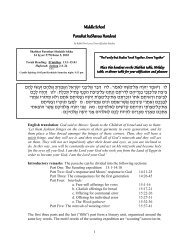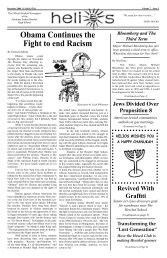Volume 1, Issue 5 (June 2011) - The Heschel School
Volume 1, Issue 5 (June 2011) - The Heschel School
Volume 1, Issue 5 (June 2011) - The Heschel School
You also want an ePaper? Increase the reach of your titles
YUMPU automatically turns print PDFs into web optimized ePapers that Google loves.
Washington, DC and Philadelphia<br />
Beth Sholom Synagogue:<br />
Frank Lloyd Wright or Frank<br />
Lloyd Wrong?<br />
<strong>The</strong> Sixth Grade’s First Taste of Modern<br />
Architecture<br />
By Hannah Zhukovsky<br />
After an early wake-up call, the<br />
sixth graders all piled into the coach<br />
bus, then, after a long and sleepy ride,<br />
managed to stumble out of the bus into<br />
a strange pyramid figure supported by<br />
obelisks at its side; the building is the<br />
Beth Sholom Synagogue designed by<br />
Frank Lloyd Wright, the architect of the<br />
Guggenheim Museum.<br />
After walking through a long carpeted<br />
hallway, we were greeted by Mordechai<br />
and Mati Rosentein, grandparents<br />
of fellow sixth grader Ava Pearlman.<br />
We were then ushered into one of the<br />
many chapels to watch a short video<br />
about the construction of the building.<br />
<strong>The</strong> Rabbi of Beth Sholom Synagogue, at<br />
that time, was Mortimer J. Cohen. When<br />
Rabbi Cohen was at Beth Sholom, many<br />
members of the synagogue, located in<br />
Philadelphia, left to move to the suburbs,<br />
and the old building was in disrepair. He<br />
decided to move the synagogue to Elkins<br />
Park, and to build a new synagogue.<br />
Rabbi Cohen’s mission was to expand<br />
the congregation attending the Synagogue,<br />
and at the same time think about<br />
the architecture of the new building to<br />
connect Judaism with the modern world.<br />
He even said he wanted a building that<br />
had “the American spirit wedded to the<br />
ancient spirit of Israel.”<br />
In order to accomplish his dream,<br />
in 1953 Rabbi Cohen sent Frank Lloyd<br />
Wright , one of the most famous and<br />
accomplished architects in the world, a<br />
personal letter to convince him to consider<br />
the project. Frank Lloyd Wright<br />
at the time was best known for designing<br />
the extraordinary home, “Falling<br />
Water.” Wright, a Welsh Unitarian, had<br />
been asked before to design and build<br />
a synagogue, but had always refused.<br />
Rabbi Cohen would not take “no” for an<br />
answer, and after much coaxing, Wright<br />
agreed to go along with the project.<br />
After meeting, Cohen and Wright<br />
soon became great friends, and Cohen<br />
maintained the position of Co-Designer<br />
of the building, a position never given<br />
away before by Wright. Thus, they started<br />
to work on the six-sided pyramid with<br />
tripod beams laden with plastic panels<br />
within the structure, which resembled<br />
Mount Sinai.<br />
After the video, we walked up the<br />
carpeted stairs into the main sanctuary.<br />
As soon as we arrived into the room,<br />
there were gasps of “oohs”, and “aahs.”<br />
Many kids loved the open space, while<br />
others said it was too “overwhelming.”<br />
<strong>The</strong> main sanctuary, when first looked at,<br />
resembles a modern cubist design done<br />
to give the sacred holy place an “edge.”<br />
However, the inside, such as a piece of<br />
Jewish text, has many deep interpretations<br />
of mystical ideas and tradition.<br />
<strong>The</strong> only difference between the two is<br />
that the interpretations are played out in<br />
the many facets of the architecture, not<br />
words. Inside the main sanctuary, where<br />
the pyramid peaks, the floor is tilted in a<br />
certain way, which gives the effect of one<br />
being cupped in God’s hands. <strong>The</strong> Bima,<br />
a representation of angels ascending to<br />
heaven, is lined with modern shaped<br />
patterns (usually six on each side, to<br />
represent the twelve tribes) and in the<br />
middle is the triangular shaped ark with<br />
Continued on page 12<br />
So You Think You Can Fly?<br />
By Ella N. Kaplun<br />
<strong>The</strong> man who said, “Tell me, have I<br />
done anything of worth?” Is the same<br />
man who invented the Great Kite, the<br />
ornithopter flying machine, the parachute,<br />
and who painted the Mona Lisa.<br />
This Renaissance man was Leonardo Da-<br />
Vinci.<br />
During the sixth grade trip to Pennsylvania,<br />
specifically Lancaster and<br />
Philadelphia, sixth graders went to the<br />
Leonardo DaVinci exhibit in the Franklin<br />
Institute. <strong>The</strong>re, we watched a video<br />
about Leonardo, looked at Leonardo’s<br />
paintings, read his journal entries, and<br />
viewed the astounding drawings of his<br />
inventions. Much of what we saw was<br />
Leonardo’s actual writing, as well as<br />
touch screen reproductions of his work.<br />
Before we went to the museum Gary<br />
asked that we choose one invention of<br />
DaVinci’s that we’d like to take home.<br />
Would we choose: <strong>The</strong> Great Kite, Aerial<br />
Screw, Mechanical Lion and Bat, Self-<br />
Propelled Cart, or the Harpsichord Viola.”<br />
Looking at thirty-seven results,<br />
three people wanted to bring the Aerial<br />
Screw home, twenty people wanted to<br />
bring home the Great Kite, five people<br />
wanted to bring home the Mechanical<br />
Lion and Bat, five people wanted to bring<br />
home a Self-Propelled cart, and four others<br />
opted for the harpsichord-viola.<br />
In 1498, Leonardo DaVinci completed<br />
work on his painting, “<strong>The</strong> Last<br />
Supper.” He thought of flying machines<br />
400 years before electronic flying machines<br />
were made. In addition, he helped<br />
Continued on page 11<br />
<strong>The</strong> Joseph Slifka Middle <strong>School</strong> <strong>June</strong> <strong>2011</strong> ◆ 7



